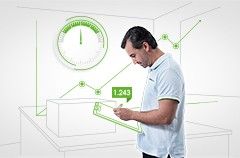
Solutions for Ion-Selective Electrodes
Ready-To-Use Ion Calibration Standards, Ionic Strength Adjustors, and Electrolytes
Solutions for ion-selective electrodes (ISE) are standards for properly calibrating and maintaining ISE sensors. METTLER TOLEDO's portfolio of quality ISE solutions provides everything needed for successful ion detection, including ready-to-use ion calibration standards, ionic strength adjusters (ISAs), and electrolytes. With our ready-to-use calibration standards, no weighing or diluting is required, while the ISAs ensure accurate readings from your ISE. The most common calibration standards are available in concentrations of 10, 100, and 1000 mg/L (ppm).
Advantages of METTLER TOLEDO's pH Electrolytes and Maintenance Solutions

Perform Accurate Calibrations
High-accuracy ion calibration standards for calibration can be ordered at concentrations of 10, 100, and 1000 mg/L (ppm). If a lower concentration is needed, it can easily be prepared with a serial dilution.

Ensure High Repeatability with ISA
In all analytical procedures using an ISE, the correct amount of ISA (Ionic Strength Adjustor) must be added to all samples and standards prior to measurement or calibration. This solution ensures that samples and standards have similar and constant ionic strength.

Find the Right Electrolyte
It is important to fill the reference electrode of every ISE with the recommended electrolyte solution. The correct electrolyte will minimize junction potentials and provide optimum temperature and response time. The electrolyte must be refilled or replaced regularly to maintain good electrode performance.
Download Your Certificate
For maximum traceability, an individual certificate of analysis exists for every batch of ISE or ISA solution. Contact pH-CSC in order to get the solution certificate and print it for documentation purposes. Read more
Get a Safety Datasheet
To remain compliant with regulations is important. Every SDS (Safety Data Sheet) and label contains information according to the GHS (Global Harmonized System) in local languages. Read more

All-In-One Solution
METTLER TOLEDO provides entire electrochemistry systems—from meters and sensors to calibration solutions and software. Benefit from a broad portfolio, choose the right sensor for your application, and maintain and store it correctly with the proper ISE solutions.
Explore Our Services - Tailored to Fit Your Equipment
We support and service your measurement equipment through its entire life-cycle, from installation to preventive maintenance and calibration to equipment repair.
Support & Repair

FAQs
Which solutions do I need for the calibration and care of ISEs?
Measuring with ion-selective electrodes (ISE) is the easiest and most affordable way to determine ion concentration. However, ISEs require careful handling and the use of the correct solution for ion-selective electrodes. METTLER TOLEDO offers all solutions that are needed for successful ion measurements:
- Ready-to-use ion calibration standards
- Ionic strength adjustors
- Electrolytes
Which standards should I use to calibrate ion-selective electrodes?
A ready-to-use ion calibration standard is a high-precision solution for ion-selective electrodes. It can be ordered at 1000, 100 and 10 mg/L (ppm) concentrations. If a lower concentration is needed, it can easily be prepared with serial dilution, as explained in the electrode manual.
What is an ion strength adjustor?
In all analytical procedures using an ISE, the correct amount of ISA (Ionic Strength Adjustor) must be added to all samples and standards prior to measurement or calibration. This solution ensures that samples and standards have similar and constant ionic strength. Instructions for the type and amount of ISA can be found in the manual of every ISE.
Why should I refill the electrolyte of my ISE?
It is essential to fill the reference electrode of every ISE with the recommended electrolyte solution. The correct electrolyte will minimize junction potentials and provide optimum temperature and time response. The electrolyte must be refilled or replaced regularly in order to achieve good electrode performance. For more information, please refer to the electrode manual.










